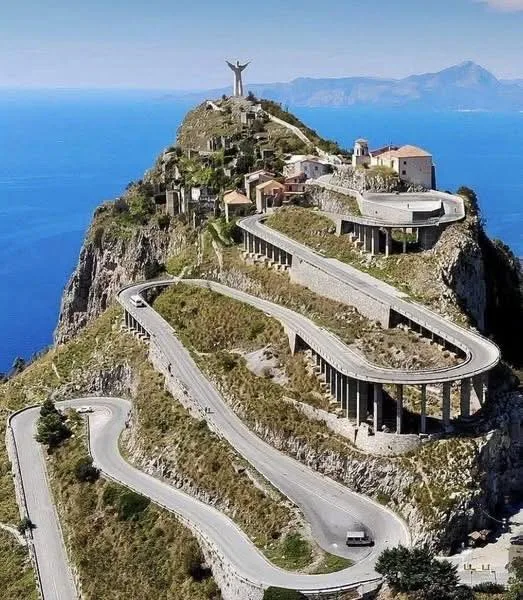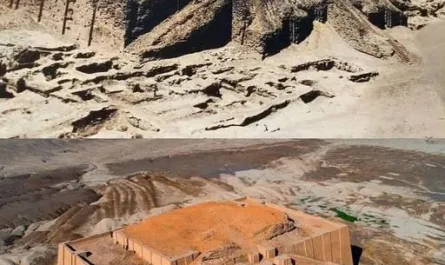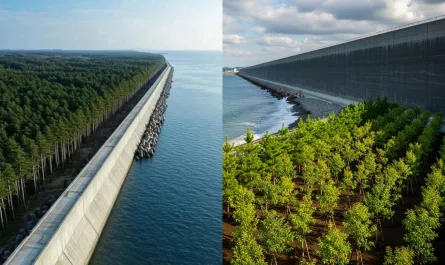Nestled along the rugged coastline of Basilicata in southern Italy, Maratea dazzles as the Pearl of the Tyrrhenian Sea. This hidden gem, often overlooked by mainstream tourist trails, combines dramatic mountains, pristine beaches, and towering cliffs with jaw-dropping views of the Tyrrhenian Sea. From the iconic Christ the Redeemer statue atop Mount San Biagio to its charming historic center, Maratea is a paradise for those seeking tranquility, natural beauty, and Mediterranean allure. Let’s explore why this unique destination should be on every traveler’s radar!

A Landscape of Dreams: Mountains, Beaches, and Cliffs
Maratea’s geography is a masterpiece of nature, blending the wild beauty of the Lucanian Apennines with the shimmering waters of the Tyrrhenian Sea. The town stretches along a 32-kilometer coastline, boasting over 20 beaches, from secluded coves to sandy stretches like Fiumicello and Acquafredda. Cliffs plunge dramatically into the sea, creating a postcard-perfect backdrop that feels both serene and awe-inspiring.
The winding roads leading to Maratea are an adventure in themselves, weaving through rugged terrain dotted with olive groves, pine forests, and picturesque villages. Whether you’re driving from Sapri or Praia a Mare, the journey offers breathtaking vistas that set the tone for Maratea’s charm. For the best experience, rent a car and take your time to soak in the scenery—each curve reveals a new slice of paradise.
The Iconic Christ the Redeemer Statue
Perched atop Mount San Biagio, the Christ the Redeemer statue is Maratea’s most iconic landmark. Standing 22 meters tall, this towering figure—second in size only to Rio de Janeiro’s famous statue—gazes over the Gulf of Policastro with outstretched arms. Built in 1965 by Italian sculptor Bruno Innocenti, it’s crafted from Carrara marble and concrete, blending seamlessly with the mountain’s rugged silhouette.
Hiking or driving to the statue’s vantage point rewards visitors with unforgettable panoramic views. On a clear day, you can see the coastline stretching toward Calabria and even glimpse the distant Aeolian Islands. Sunset visits are especially magical, as the sky ignites with hues of orange and pink, casting a glow over the sea below. Don’t forget your camera—this is a view you’ll want to capture!
A Historic Center Steeped in Charm
Maratea’s historic center, known as Maratea Borgo, is a labyrinth of cobblestone streets, colorful buildings, and historic treasures. Often called the “town of 44 churches,” Maratea boasts an astonishing number of sacred sites for its small size, each with its own story. The Basilica of San Biagio, dedicated to the town’s patron saint, houses relics and stunning frescoes, while the Church of Santa Maria Maggiore captivates with its elegant Baroque details.
Wander through lively squares like Piazza Buraglia, where locals gather for espresso and conversation, or explore hidden alleys adorned with flower baskets. The architecture reflects centuries of history, from medieval towers to Renaissance-era facades, all infused with a distinctly Mediterranean vibe. Stop by a local shop to sample Basilicata’s culinary delights, like lucanica sausage or peperoni cruschi (crispy dried peppers).
A Haven for Nature Lovers and Tranquility Seekers
Maratea is a dream destination for those who crave nature and serenity. Beyond its beaches, the surrounding mountains offer hiking trails through the Parco del Monte San Biagio and nearby Pollino National Park. Paths wind through lush forests, past ancient caves, and to scenic lookouts, perfect for adventurers and photographers alike.
For water enthusiasts, Maratea’s crystal-clear waters are ideal for swimming, snorkeling, or boat tours. Explore hidden sea caves like the Grotta del Sogno or dive into the underwater world of the Tyrrhenian, where marine life thrives among colorful coral reefs. If relaxation is your goal, simply lounge on a beach with a gelato in hand, letting the sound of waves wash away your cares.
Practical Tips for Visiting Maratea
-
Getting There: Maratea is accessible by train to Maratea Station (on the Naples-Reggio Calabria line) or by car via the A3 motorway, exiting at Lagonegro or Lauria. The closest airports are Naples (about 2.5 hours away) or Lamezia Terme (3 hours).
-
Best Time to Visit: Spring (April–June) and early autumn (September–October) offer mild weather and fewer crowds. Summer is vibrant but busier, especially in August.
-
Where to Stay: Choose from charming B&Bs in the historic center, seaside hotels, or villas with panoramic views. Hotel Santavenere and La Locanda delle Donne Monache are top picks for luxury and charm.
-
Dining: Savor fresh seafood at Ristorante Da Cesare or try regional dishes at Taverna Rovita in the historic center. Don’t miss Basilicata’s wines, like Aglianico del Vulture.
-
Must-Do: Take a sunset boat tour along the coast, visit the Christ the Redeemer statue, and explore at least one of Maratea’s beaches, like Spiaggia Nera with its striking black sand.
Why Maratea Stands Out
Unlike Italy’s more famous coastal destinations like Amalfi or Cinque Terre, Maratea remains a hidden treasure, offering an authentic and uncrowded experience. Its blend of natural beauty, rich history, and Mediterranean charm makes it ideal for travelers seeking both adventure and tranquility. Whether you’re marveling at the views from Mount San Biagio, strolling through the historic center, or basking on a sun-kissed beach, Maratea captivates the soul.
Plan Your Visit to the Pearl
Maratea is more than a destination—it’s a love letter to Italy’s wild and beautiful south. Whether you’re drawn to its dramatic landscapes, spiritual landmarks, or quaint villages, this Pearl of the Tyrrhenian Sea promises memories that linger long after you leave. Have you visited Maratea, or is it on your travel list? Share your thoughts, and let’s keep the conversation going!





